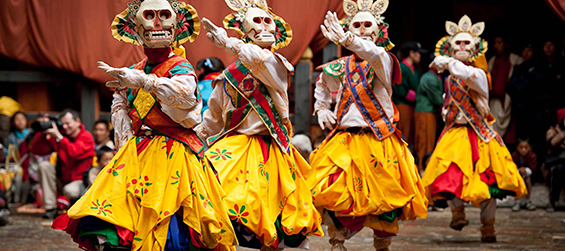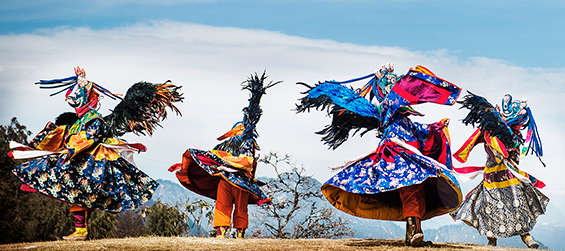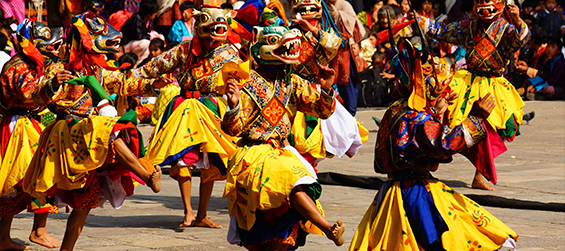Buthan Festival (Thimphu Tshechu)
Happiness is a place: Bhutan
(08th – 21th October)
08 OCTOBER: ARRIVE DELHI BY EARLY MORNING FLIGHT
Meeting and assistance at Delhi Airport and transfer to hotel. Arrive and check – in at hotel.
Rest of day at leisure.
Overnight at hotel.
09 OCTOBER: DELHI - PARO BY DRUK AIR
Early morning transfer to Delhi Airport to board Druk Air flight to Paro.
Druk Airways flight to Bhutan is one of the most spectacular in entire Himalayas. Each flight is a mesmerizing aeronautical feat and offers an exciting descent into the Kingdom. Bhutan’s first gift to you as you disembark from the aircraft will be cool, clean fresh mountain air. After immigration formalities and baggage collection, you will be met by our representative, and afterwards escort to hotel in Paro.
Paro at an altitude of 2200 m/ 7218 ft, is the one of the most beautiful valleys in Bhutan, it is home to many of Bhutan's oldest temples and monasteries, National Museum and country's only airport. Mount. Chomolhari (7,314m) reigns in white glory at the northern end of the valley and its glacial water plunge through deep gorges to form Pa Chhu (Paro River).
Later the day stroll around the town/market place.
Overnight at hotel in Paro.
10 OCTOBER: PARO – HIKE TO THE FAMOUS TIGER’S NEST (5 HRS – ROUND TRIP)
(Approx 5 hrs round trip walks)
After breakfast take a short drive to Satsam Chorten, stop en route at the 7th century Kyichu Lhakhang, one of the 108 temples built in the Himalayas by Tibetan King, Songtsen Gampo. The building of this temple marks the introduction of Buddhism in Bhutan.
On arrival at trail-head point, embark on a walking excursion to Taktshang Monastery: It is one of the most famous of Bhutan’s monasteries, perched on the side of a cliff 900 m above the Paro valley floor. It is said that Guru Rinpoche arrived here on the back of a tigress and meditated at this monastery and hence it is called ‘Tiger’s Nest’. This site has been recognized as a most sacred place and visited by Shabdrung Ngawang Namgyal in 1646 and now visited by all Bhutanese at least once in their lifetime. On 19 April, 1998, a fire severely damaged the main structure of building but now this Bhutanese jewel has been restored to its original splendor.

Lunch at the famous Taktsang cafeteria overlooking the Tiger’s nest hanging on to the Cliffside.
Afternoon visit Ta Dzong, originally built as Watchtower, which now houses National Museum. The extensive collection includes antique thangkha paintings, textiles, weapons & armour, household objects and a rich assortment of natural and historic artifacts.
Also explore Rinpung Dzong (festival venue), meaning (“fortress of the heap of jewels”), which has a long and fascinating history. Along the wooden galleries lining the inner courtyard are fine wall paintings illustrating Buddhist lore such as four friends, the old man of long life, the wheel of life, scenes from the life of Milarepa, Mount. Sumeru and other cosmic Mandala.
Overnight at hotel in Paro
11 OCTOBER : PARO - THIMPHU (55 KMS / 2 HRS. approx.)
After breakfast drive towars Thimphu. After checking into hotel, proceed for the guided tour of city’s main attractions that includes:
Textile Museum: is worth a visit to get to know the living national art of weaving. Exhibitions introduce the major weaving techniques, styles of local dress and textiles made by women and men.
National Library: The history of Bhutan lies imprinted in archaic texts, which are preserved at the National Library. Besides thousands of manuscripts and ancient texts, the library also has modern academic books and printing blocks for prayer flags.
Institute for Zorig Chusum: Commonly known as Arts & Crafts School or Painting School, the Institute offers a six-year course on the 13 traditional arts and crafts of Bhutan. On a visit, one can see students learning the various skills taught at the school.
Simply Bhutan Museum: The newly commissioned museum depicts the ancient Bhutanese architecture which is being lost to modernization. The uniqueness of the structure is in its composition of the materials used. The structure is built reusing old timber, window and door frames and other items from traditional and old demolished houses. The best part is the portrayal of the age-old life styles of the Bhutanese people.
Visit Cheri Monastery. Lunch followed by city tour that includes:
Memorial Chorten: The stupa built in the memory of Bhutan's third King, His Late Majesty, KingJigme Dorji Wangchuk, who is popularly regarded as Father of modern Bhutan. The paintings and statues inside the monument provide a deep insight into Buddhist philosophy.
Buddha Point (Kuensel Phodrang). Located at a short drive from Thimphu city centre, visitors can get a good overview of the Thimphu valley from the Buddha point (Kuensel Phodrang). You can pay your obeisance and offer prayers to the Buddha, the largest statue in the country and then walk around and take a glimpse of the valley.
Conclude the tour of the day with a visit of Trashichhoe dzong, “fortress of the glorious religion”. This is the center of government and religion, site of monarch’s throne room and seat of Je Khenpo or Chief Abbot. Built in 1641 by the political and religious unifier of Bhutan, Shabdrung Ngawang Namgyal, it was reconstructed in 1960s in traditional Bhutanese manner, without nails or architectural plans.
Overnight at the hotel in Thimphu.

12 OCTOBER: THIMPHU FESTIVAL
After breakfast proceed to festival venue to witness Thimphu Tshechu (date 11 - 13 Oct’16)
The religious festivals (Tshechu in local term) are held in several parts of Bhutan as a tribute to Guru Padsambhava (also referred to as Guru Rimpoche) – ‘one who was born from lotus flower’ and introduced the Nyingma school of Buddhism into Tibet, Nepal and Bhutan in 8th century.
Each 10th day of the lunar calendar is said to commemorate a special event in the life of Padmasambhava; and some of these are dramatized in the context of a religious festival or the Tshechu.
During Tshechus, the dances are performed by monks as well as laymen wearing ornate costumes and masks; the each aspect dance has a symbolic meaning. It is widely believed that one gains merit by attending any of these festivals. Some of the festivals are observed to purify the souls and ward off evil spirit, not necessarily with religious mask dance.
Moreover, it is also a yearly social gathering where the Bhutanese people, dressed in all their finery, come together to rejoice, taking a break from their everyday life.
Overnight at the hotel in Thimphu.
13 OCTOBER: THIMPHU – PUNAKHA (75 KM, 3 HRS APPROX)
After breakfast at hotel, drive to Punakha across Dochula pass (3, O8Om). In Bhutan, the passes are marked by a large Bhutanese Chorten and prayer flag. Dochula pass offers the most spectacular view over the high peaks of the eastern Himalayas on a clear day.
Afternoon visit Punakha Dzong or (Palace of Great Happiness), built at the junction of the Phochu and Mochu rivers in 1637 by Shabdrung Ngawang Namgyal. This majestic dzong served as both the religious and the administrative center of Bhutan in the past. It measures some 600 by 240 feet and has a six-story, gold-domed tower. Inside are courtyards and religious statuary that hint at the depth of history and spiritual tradition embodied here. Your guide will illuminate your understanding of this intricate culture that is exotic to us, though long established here.
Later in the day excursion to Chimi Lakhang (from hotel it is about 15 minutes drive till motorable road and then walk starts through paddy fields and villages. This is total about 1.1/2 hour walk, including both way)
The Chimi Lhakhang, situated on a hillock in the centre of the valley, also known as the temple of fertility. It is widely believed that couples who do not have children and wanting one, if they pray at this temple, they are usually blessed with a child very soon. The trail leads across rice fields to the tiny settlement of Pana, meaning ‘field’. A walk through the village near the temple will give you rare glimpses into the daily life and lifestyle of the villagers.
Overnight at the hotel in Punakha.
14 OCTOBER: PUNAKHA – BUMTHANG VIA TRONGSA (200 apprx 7 hrs)
After breakfast drive to Bumthang crossing Pele-la pass (3300m/10830 ft) via Trongsa,. The Pela La (pass) is marked by a large white chorten prayer flags. There is an abrupt change in vegetation at this point, with mountain forest replaced by high altitude dwarf bamboo.
Stop en route at Chendbji Chorten, patterned on Kathmandu’s Swayambhunath Stupa, with eyes panted at four cardinal points.
Stop at Trongsa for lunch.
After lunch visit Trongsa Dzong, built in 1648 it was the seat of power over central and eastern Bhutan.
Also visit Ta Dzong, recently opened fort in Trongsa. The Ta Dzong, a cylindrical stone structure rising five stories, was built in 1652 by Chogyal Minjur Tempa, After more than 350 years, it has been resurrected into a classy museum, that represents a tasteful blend of tradition and modernity.
Further 68 km drive across the Yutong-la pass (3,400m/ 11,155 ft) finally brings you to wide open cultivated Bumthang valley.
Overnight at hotel in Bumthang.
15 OCTOBER: BUMTHANG
After breakfast proceed for the tour of Bumthang valley:
Bumthang is the general name given to combination of four valleys – Chumey, Choekhor, Tang and Ura with altitude varying from 2,600m to 4,000m. It is home to many of prominent Buddhist temples and monasteries.
Visit Kurje Lhakhang, where the saint Padmasambhava subdued a local demon and left his body imprint on a rock, the Jambey Lhakhang (7th century temple), Tamshing Lhakhang (housing some of the oldest wall paintings in Bhutan) and Jakar Dzong (administrative center of the region). Stroll in the village, visit the little handicrafts shop at the entrance to the town, and perhaps take refreshments at a local restaurant.
Overnight at Hotel in Bumthang

16 OCTOBER: BUMTHANG – MONGAR (198 km, 7 hours)
The journey continues eastwards winding through more rugged terrain. The drive, with spectacular views will take about 7 hours. Pass through Ura village in Bumthang before climbing sharply to the highest motorable pass in the Kingdom, the Thrumshing la pass - 4000m. Gradually drop down to Sengor, watching cascading waterfalls on the way. The descent stops at 700m on a bridge over the Kurichu. Ascent again through pine forests, maize fields and eastern hamlets to Mongar town. Visit Mongar Dzong; built albeit quite recently, the dzong still maintains the architectural traditions of old dzongs.
Overnight at Hotel in Mongar.
17 OCTOBER: MONGAR-TRASHIGANG (96 KMS / 03 HRS)
(96 km, 3 hours) This trip of about 96 kms takes 3 hours passing through Kori la pass (2,450m), the place marked by a pretty chorten and a stone wall. The first part of journey is through leafy forest filled with ferns. Later road descends rapidly through corn fields and banana groves arriving the famous zigzags of Yadi, which is a recent settlement. After that follows the Gamri River until the bifurcation to Dametsi, this temple perched on top of steep hill was founded by Choeden Zangmo and is the most important monastery of eastern Bhutan. This is the place from where the famous Naga Chham, masks dance with drums originated. About 30km onwards lays Tashigang at l000mts.Trashigang is the center of the biggest and most populated district in the country. Visit Trashigang Dzong, standing at the extreme end of the spur, overhanging the Gamri River. It serves as the administrative seat for the district and part of the dzong is occupied by the Drukpa monastic community.
Overnight at the lodge in Trashigang.
18 OCTOBER: TRASHIGANG (EXCURSION TO TRASHIYANGTSE)
24 km from Trashigang, visit the temple of Gom Kora, set on a small alluvial plateau, overlooking the river. Gom Kora is a famous place where Guru Rinpoche subdued a demon. Further ahead reach to Doksum village where you can see women busy in weaving traditional Bhutanese fabric and a chain bridge dating of the 15th century. Visit Trashiyangtse Dzong, situated at the alt. of 1,850 m. In former times Trashiyangtse was important centre because it lies on one of the caravan routes leading from western and central Bhutan. Thedzong is new and nearby are the Art school and the famous chorten Kora. Evening return to Trashigang.
Overnight at the lodge in Trashigang.
19 OCTOBER: TRASHIGANG - SAMDRUP JONGKHAR (180 km, 7 hours)
Drive to eastern border town of SamdrupJonkar passing by Sherubtse College, the only college in country founded in 1978. En route stop at Zangtho Pelri temple, it represents Guru Rinpoche's paradise. Drive further ahead to Khaling to visit the Blind School and Weaving Centre. Deothang, 80 kms from Khaling is the centre of Technical training college and road maintenance headquarters for the east. From here the road descends fairly rapidly to the plain through a dense tropical forest with an abundance of teak, bamboo and ferns.
Overnight at the lodge in SamdrupJongkhar.
20 OCTOBER: DEPART SAMDRUP JONGKHAR
SAMDRUP JONGKHAR - GUWAHATI IN INDIA (110 KM/ APPROX 3 HOURS) GUWAHATI – DELHI BY FLIGHT (AI 890 – 1730 / 2005 HRS.)After breakfast transfer to Bhutan border where you will be picked up by Indian representative for onward program. (SamdrupJongkhar – Guwahati in Assam, India) 110 km, approx 3 hours. Arrive Guwahati and transfer to hotel for lunch. Later transfer to Guwahati Airport to board flight to Delhi.
Overnight stay at hotel in Guwahati.
and enjoy the evening amid the wildlife and Mother Nature.
Overnight at hotel in Delhi.

21 OCTOBER: DEPARTURE BY EARLY MORNING FLIGHT
Breakfast at hotel. Later in time transfer to airport for flight back home.
End of Our Services
CLOSING DAYS OF SOME OF MONUMENTS MENTIONED IN ITINERARY:
- Ta Dzong – Paro (national museum): closed on Government Holidays
- National Library – Thimphu: closed on Sat, Sun & Government Holidays
- Folk Heritage Museum - Thimphu: closed on Government Holidays and on Sat open from 10.30 a.m to 1.00 p.m and on Sun open from 11.30 a.m to 3.00 p.m
- Textile Musuem – Thimphu: Closed on Government Holidays and on Sun and on Sat open from 9.00 a.m to 4 p.m
- Institute of Zorig Chusum (Arts & Crafts School) - Thimphu: Closed on Sun & Government Holidays and on Sat open from 10 a.m to 12 o’clock.









